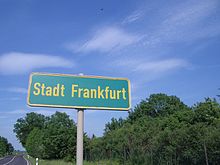City of Frankfurt
Frankfurt is one of the district town of Wanzleben the town Wanzleben-Börde belonging village in Saxony-Anhalt .
location
The small settlement in the Magdeburg Börde has 35 inhabitants (as of 2008) and is located southwest of Wanzleben, south of the federal highway 246 leading from Oschersleben to Wanzleben . Nearby is a small bump 113 meters high. To the north of the city of Frankfurt are the old blue and white guard towers . In the vicinity of the place there are various desert areas , such as Niendorf , Wendisch-Schaaftal , Zennewitz , Hohenwend and Kotzlitz .
The village has a population of maple, birch, ash, linden and Canadian poplar.
history
The settlement emerged from an inn Zur Stadt Frankfurt , to which the settlement owes its unusual name, given its small size.
The inn was first mentioned in a document in 1825. At this point in time, the inn was shown on the map of the district of Neuhaldensleben . Today's federal road was originally the Magdeburg - Halberstadt post road . The actual year of construction and the founder of the inn are not known. Presumably it originated at the beginning of the 19th century. The reason for naming the inn is also unknown.
In 1842 the inn was listed as part of the Klein Oschersleben community , and in 1864 as part of Wanzleben.
In 1861, a census counted 7 residents in three households. At the beginning of the 1860s, a Vorwerk of the manor Groß Germersleben was set up in the place. However, there was also a reaper's barracks that housed 60 seasonal workers. Quarry stones from the sheathing of the blue observation tower were used to build the reapers barracks. In addition to a flock of sheep and two horses, 60 oxen were kept. The outwork was surrounded by a high wall. In the evening the big gate was closed. Horse and sheep stables were on the western side of the yard. The east side was occupied by the reapers barracks, the house and stables. The laundry room, tool shed and, above all, ox stalls stood on the south side.
The population was then given in 1879 as 48 and in 1885 as 68. The population later fell again.
In 1884 the Korn company from Wanzleben added an extension to the residential building of the Vorwerk. At least in 1885, the inn was the site of the wood auction for the wood that came from the pruning of the trees on the road. In 1888 there were still 56 people living in the city of Frankfurt. In 1899 the inn , which had a beer garden , closed. However, it was probably reopened a short time later. At least in autumn 1900 the life reformer Gustav Nagel stayed overnight in the city of Frankfurt. He was traveling on foot towards southern Germany, Switzerland and Italy . In the inn, guests present tried to encourage the abstinent nail to drink alcoholic beverages. However, Nagel stuck to water and fruit.
In 1910 the Schnitter barracks was expanded. An old barn was located southwest of the city of Frankfurt and was surrounded by poplars.
For 1945 the population is given as 35 to 40. At the end of the Second World War , people were displaced from East Prussia , Pomerania and the Sudetenland . The land reform resulted in an expropriation of the property in the Vorwerk. Ten new farmer positions were set up, each with 5 hectares of arable land and 12 ares of garden land. Initially, the new farmers were housed in the old house of the Vorwerk and in the Schnitter barracks. In 1951/1952, 10 small houses and stables were built along the settlement route. The settlement road, which, apart from the federal road, is the only road in the city of Frankfurt, was prepared with 10 tons of slag brought in from Thale . In 1953, a water pipe was laid from the old well of the Vorwerk to the property, as two new holes for water had remained unsuccessful.
In the period after 1945 the city of Frankfurt received its own post office. The inn itself was run by the innkeeper Werner for a short time after 1945 , but has been empty since then. In the 1950s, the Bördem painter August Bratfisch made several pen drawings in the vicinity of Frankfurt.
In 1954 a culture room was set up in the barracks, which was also equipped with a television . In 1957 a kindergarten for 14 children was set up in the Schnitter barracks . There was a small hall above the kindergarten. Various agricultural products such as grain, fodder, fertilizers and pesticides were also stored on this floor. A bus shelter was built in December 1970.
On September 3, 1958, the LPG Type I "Blue Wait" city of Frankfurt was founded. In 1973 the LPG was merged with other cooperatives. After another merger, it became part of LPG III German-Soviet friendship .
After the political turning point in 1989, there were no longer any farms in the city of Frankfurt. In 1990 a car recycling company and a pipe cleaning company were established. A landscaping company followed. The population had dropped to 25 by 1995.
With the decision of the city council of Wanzleben on December 21, 1996, a wind farm was set up near the city of Frankfurt . The settlement path was renovated in 2000. The population increased from 30 in 2000 to 34 in 2005.
While the settlement houses in the 1950s were rebuilt, expanded and refurbished and are still inhabited today, both the old inn and the old residential building, including the barracks, are unused and derelict.
literature
- Gerd Gerdes : Chronicle of the City of Wanzleben 889–2010, Volume 2, The old districts. dr. ziethen verlag, Oschersleben 2010, ISBN 978-3-86289-001-9 , p. 65 ff.
Coordinates: 52 ° 2 ' N , 11 ° 23' E

